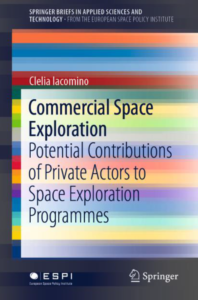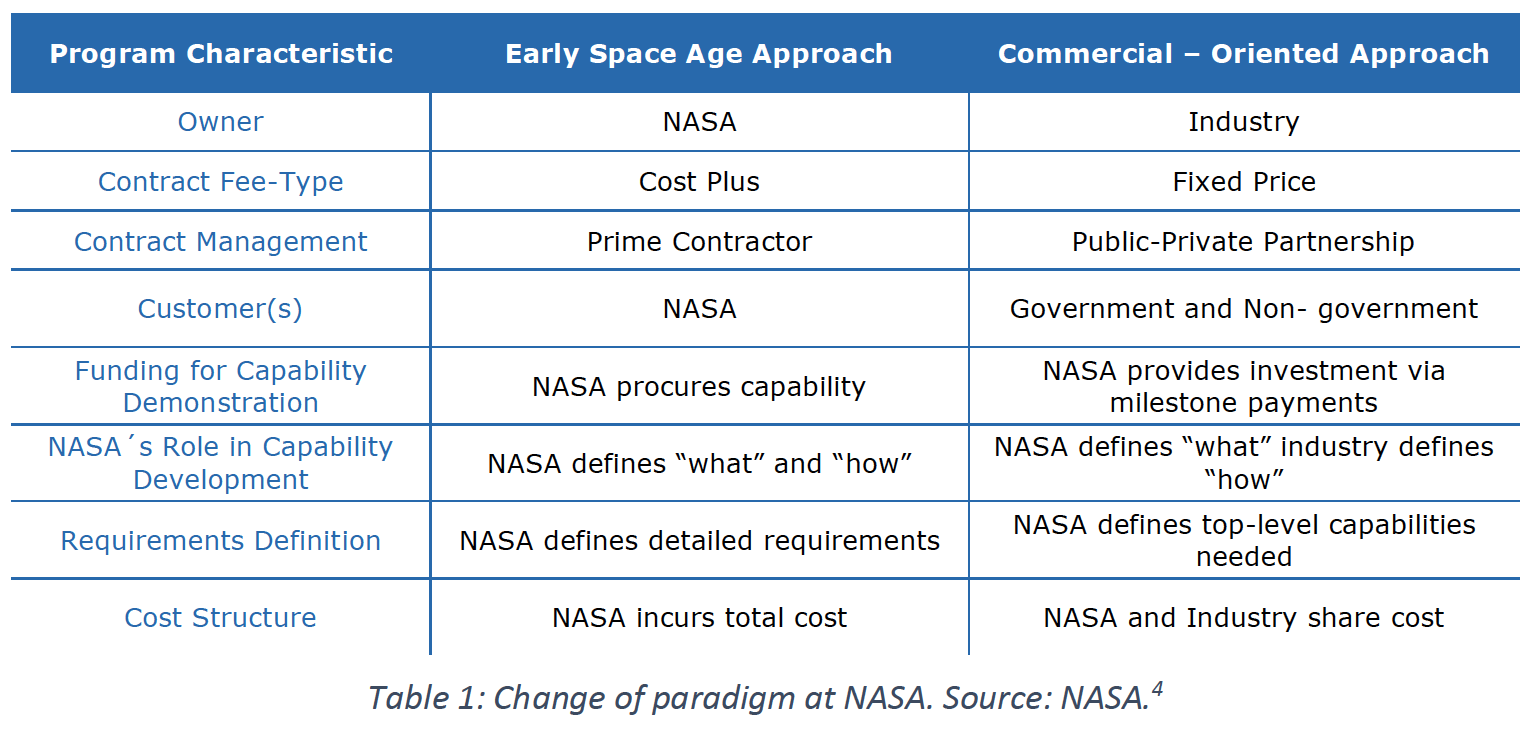 As part of the partnership between SpaceWatch.Global and the European Space Policy Institute, we have been granted permission to publish selected articles and briefs. This is ESPI Executive Brief “Commercial Space Exploration”, originally published in July 2019. Please read here an excerpt:
As part of the partnership between SpaceWatch.Global and the European Space Policy Institute, we have been granted permission to publish selected articles and briefs. This is ESPI Executive Brief “Commercial Space Exploration”, originally published in July 2019. Please read here an excerpt:
Toward a Paradigm Shift?
 Despite multiple attempts to foster a cross-fertilisation with commercial activities,1 outer space exploration and Human spaceflight, two domains intrinsically related, remain essentially funded and led by governments through national and international programmes. The substantial cost of space exploration missions and lack of business case (so far) limited the emergence of commercial leadership in this field. As a consequence, and despite a strong political will, the involvement of commercial actors in space exploration programmes remained limited, in general, to the role of contractors.
Despite multiple attempts to foster a cross-fertilisation with commercial activities,1 outer space exploration and Human spaceflight, two domains intrinsically related, remain essentially funded and led by governments through national and international programmes. The substantial cost of space exploration missions and lack of business case (so far) limited the emergence of commercial leadership in this field. As a consequence, and despite a strong political will, the involvement of commercial actors in space exploration programmes remained limited, in general, to the role of contractors.
This situation evolved to some extent with the retirement of the Space Shuttle and the introduction of the Commercial Orbital Transportation Services (COTS) programme. Driven by the objective to improve cost-effectiveness and share development and operations risks with private partners, NASA implemented an innovative procurement scheme based on competitive, performance-based, fixed-price milestones.2 The financial and operational success of this programme marked an important milestone in the evolution of the relationship between government and industry, demonstrating that more ambitious partnerships between public and private actors could yield great benefits. Fostering the involvement of commercial actors in public programmes is nowadays a dominant consideration of governments and agencies who are increasingly eager to explore new mechanisms and take advantage of commercial contributions to achieve challenging space exploration goals.
The growing opportunity of a more prominent contribution of commercial actors to space exploration also lies in the so-called “New Space” ecosystem, a business-driven dynamic of the space sector which is characterised by a substantial increase of private investment and commercial endeavours seeking to develop disruptive industrial and business concepts to address new markets. In this ecosystem, space exploration and Human spaceflight have become domains of interest for private companies, entrepreneurs and investors, eager to conduct business in these fields.
This general context creates programmatic opportunities and strategic challenges for space agencies, opening the way to a (possible) paradigm shift in the approach to space exploration in the future.
Space Exploration Programmes: New Ambitions, New Ways
New impetus in space exploration ambitions
Recent years have been marked by a new impetus in international space exploration plans.
A first important step was made by the current U.S. administration with the signature of NASA’s Transition Authorization Act by President Donald Trump in March 2017. The document underlined a strong willingness of the U.S. to engage more actively in human space exploration with the development of a gateway in cis-lunar orbit as the next programmatic step to prepare the journey to Mars. This objective was later confirmed by the adoption of the Space Policy Directive 1 “Reinvigorating America’s Human Space Exploration Program” calling for a return to the Moon in cooperation with international and commercial partners under a (renewed) American leadership. More recently, in March 2019, NASA was requested by the National Space Council to accelerate its initial programmatic roadmaps to return to the Moon by 2024, giving way to a revision (not yet settled) of the required budget.
This ambitious goal also gave way to a debate on the future of the ISS in light of the difficulty for the U.S. administration to support both programmes simultaneously. Among different options, a transfer of the station to the private sector appears to be the solution preferred by the current administration and some initial steps were made in this direction (i.e. commercial studies and consultations). The question of the future of the ISS faces major programmatic, political, legal, technical and even diplomatic issues and will not be easily settled. In the meantime, the station should provide an ideal testbed for new public-private partnerships and commercial endeavours.
These Moon exploration plans gained an international dimension with the signature of several joint statements between NASA and other space agencies (including with ESA in March 2019). These recent developments suggest that the current vision provides a fertile environment for international partners to contemplate a financially and technically conceivable contribution to the programme, in line with their own objectives. Such international dimension is a crucial feature to translate the U.S.-led vision into a tangible programme. The experience of the ISS programme showed that, beyond the value of burden-sharing for joint benefits, a cooperation framework with collective commitments is essential to ensure long-term stability in a changing political environment.
Even though no agreement has been reached yet, space agencies are now engaging more proactively in strategic and programmatic reflexions and options are shaping up. The book offers an overview of the current state of affairs, including public space exploration strategies and programmes in the World. Of course, space exploration programmes go far beyond large international programmes and count with multiple robotic missions addressing different scientific objectives. However, the book shows that larger and longer endeavours offer a more solid foundation for commercial contributions.
A more prominent role for private industry and commercial solutions
Governments seek to give a more prominent role to the private sector for mutual benefits.
Space agencies and other public institutions are actively seeking new ways to work with the private sector for the implementation of their space programmes. They aim to leverage joint investments, risk sharing schemes and more efficient arrangements to better achieve public objectives while supporting sectoral growth and innovation more effectively.
Updated in January 2018, the Global Exploration Roadmap explicitly underlines that “growing capability and interest from the private sector indicate a future for collaboration not only among international space agencies, but also with private entities pursuing their own goals and objectives”.3 This objective is not new and multiple initiatives already took place, in particular in the frame of the ISS programme. In this respect, the Commercial Orbital Transportation Services (COTS) programme has been a stepping stone with widely-recognized results in the improvement of cost-effectiveness and schedule management as well as in the stimulation of private development of commercial space transportation systems. In the wake of this success, and with the objective to further revisit public-private relationships and explore new mechanisms to stimulate business development, NASA launched various initiatives such as the Lunar Cargo Transportation and Landing by Soft Touchdown (Lunar CATALYST) initiative, the Commercial Lunar Payload Services (CPLS) programme or the Next Space Technologies for Exploration Partnerships (NextSTEP) among others. The Agency also revealed, in May 2019, a new plan to stimulate the commercial use of the ISS including a policy to allow new commercial activities on the station and transport of private astronauts, a pricing for cargo transfer and on-board services and new options to attach commercial modules.
These different initiatives and plans are part of an overall change of paradigm at NASA, summarised in the following table:
As a pioneer in developing commercial space activities, Europe has long taken full stock of the importance of better integrating the commercial component in its space exploration ambitions. In this frame, ESA and national agencies are actively exploring new ways to work with industry and foster business growth and innovation through different policies and instruments.
 As part of its Space 4.0 vision, ESA aims to pursue a consistent and forward-looking space exploration programme designed to “further stimulate commercial partnerships with industrial entities.”5 David Parker, ESA Director of Human Spaceflight and Robotic Exploration, commented that “commercial partnership will play a growing role in the exciting ESA vision for space exploration and […] ESA intends to stimulate private sector engagement in space exploration and foster innovative and inspiring approaches for ISS services and utilization and future ESA missions.”6 In this field, a recent outstanding ESA initiative is the launch of a Call for Ideas (CFI), establishing a process to launch strategic partnerships with the private sector and positioning ESA as a business partner and sponsor of selected commercial initiatives for space exploration and exploitation of the ISS.
As part of its Space 4.0 vision, ESA aims to pursue a consistent and forward-looking space exploration programme designed to “further stimulate commercial partnerships with industrial entities.”5 David Parker, ESA Director of Human Spaceflight and Robotic Exploration, commented that “commercial partnership will play a growing role in the exciting ESA vision for space exploration and […] ESA intends to stimulate private sector engagement in space exploration and foster innovative and inspiring approaches for ISS services and utilization and future ESA missions.”6 In this field, a recent outstanding ESA initiative is the launch of a Call for Ideas (CFI), establishing a process to launch strategic partnerships with the private sector and positioning ESA as a business partner and sponsor of selected commercial initiatives for space exploration and exploitation of the ISS.
…
The full executive brief ESPI Executive Summary: Commercial space exploration can be find here.
Rights reserved – this publication is reproduced with permission from ESPI. “Source: ESPI “Commercial Space Exploration” , July 2019. All rights reserved”
For more articles please visit ESPI website (www.espi.or.at).






